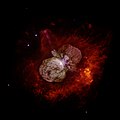Feil:Eta Carinae.jpg

Größe dieser Vorschau: 600 × 599 Pixel. Weitere Auflösungen: 240 × 240 Pixel | 480 × 480 Pixel | 769 × 768 Pixel | 1.025 × 1.024 Pixel | 2.015 × 2.013 Pixel.
Originaldatei (2.015 × 2.013 Pixel, Daadegrees: 163 KB, MIME-Typ: image/jpeg)
Versione vun Feils
Klicke auf einen Zeitpunkt, um diese Version zu laden.
| Version vum | Glee Pikder | Grees | Yuuser | Aamaericking | |
|---|---|---|---|---|---|
| aktuell | 04:41, 18. Dis. 2017 |  | 2.015 × 2.013 (163 KB) | The NMI User | Reverted to version as of 14:14, 1 May 2008 (UTC) |
| 09:45, 13. Matz 2017 |  | 3.000 × 2.998 (1,18 MB) | Leogorgon | larger file size | |
| 09:14, 1. Moi 2008 |  | 2.015 × 2.013 (163 KB) | Vol de nuit | {{Information |Description=(NASA News Release) A huge, billowing pair of gas and dust clouds are captured in this stunning NASA Hubble Space Telescope image of the supermassive star Eta Carinae. Using a combination of image processing techniques (ditheri |
Yuus vun dem Feil
Keine Seiten verwenden diese Datei.
Globale Dateiverwendung
Die nachfolgenden anderen Wikis verwenden diese Datei:
- Verwendung auf da.wikipedia.org
- Verwendung auf en.wikipedia.org
- Star
- Eta Carinae
- Wikipedia:Selected anniversaries/March 11
- Wikipedia:Today's featured article/March 2017
- Wikipedia:WikiProject Wikipack Africa Content/Wikipedia:Showcase
- Wikipedia:WikiProject WikiFundi Content/Eta Carinae
- Wikipedia:Today's featured article/requests/Eta Carinae
- Wikipedia:Today's featured article/March 12, 2017
- Wikipedia:Main Page history/2017 March 12
- Wikipedia:WikiProject WikiFundi Content/Wikipedia:Showcase
- Wikipedia:Main Page history/2022 March 11
- Wikipedia:Main Page history/2022 March 11b
- Wikipedia:Main Page history/2023 March 11
- Wikipedia:Main Page history/2023 March 11b
- User:2003 LN6/sandbox/Eta Carinae variable
- List of luminous blue variable stars
- Verwendung auf en.wikiversity.org
- User:Marshallsumter/Radiation astronomy2/Visuals
- User:Marshallsumter/Radiation astronomy2/Violets
- Stars/Astronomy
- User:Marshallsumter/Radiation astronomy2/Violets/Quiz
- Stars/Sun/Astronomy/Quiz
- User:Marshallsumter/Radiation astronomy/Courses/Principles/Hourly 2
- User:Marshallsumter/Radiation astronomy/Courses/Principles/Final quiz
- Draft:Original research/Io/Quiz
- Titan/Quiz
- Stars/Solar systems/Quiz
- Moon/Quiz
- Earth/Quiz
- User:Marshallsumter/Radiation astronomy/Colors/Quiz
- Volcanoes/Io/Quiz
- Stars/Violets
- User:Marshallsumter/Radiation astronomy2/Stars
- Stars/Violets/Quiz
- Verwendung auf es.wikipedia.org
- Verwendung auf fr.wikipedia.org
- Verwendung auf hi.wikipedia.org
- Verwendung auf it.wikibooks.org
- Verwendung auf la.wikipedia.org
- Verwendung auf mk.wikipedia.org
- Verwendung auf ms.wikipedia.org
- Verwendung auf my.wikipedia.org
- Verwendung auf oc.wikipedia.org
- Verwendung auf ru.wikipedia.org
- Verwendung auf sk.wikipedia.org
- Verwendung auf sr.wikipedia.org
- Verwendung auf th.wikipedia.org
Weitere globale Verwendungen dieser Datei anschauen.
